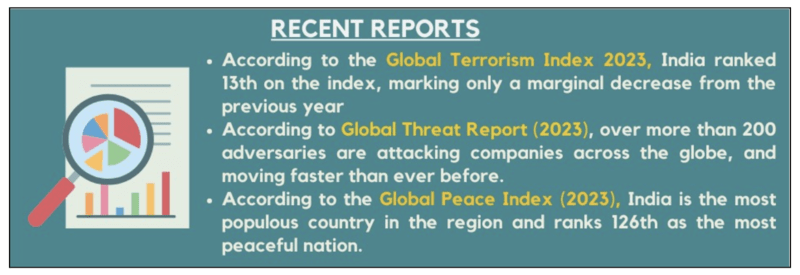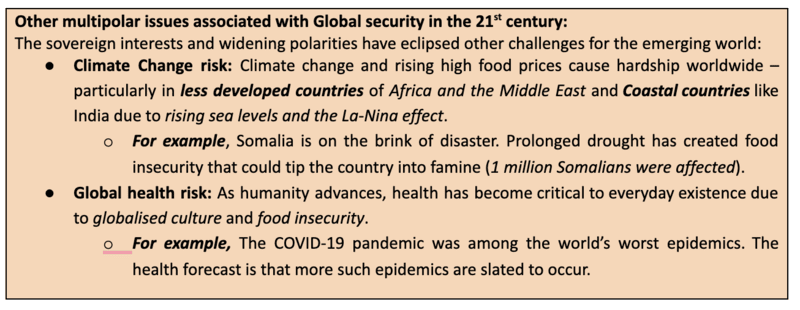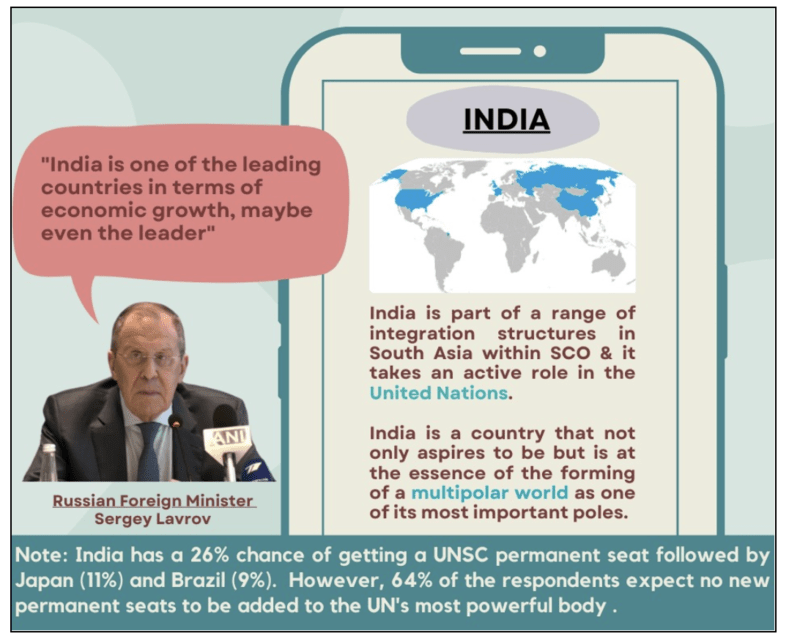Security Risks
“The power for creating a better future is contained in the present moment: You create a good future by creating a good present.” - Eckhart Tolle
Relevance: GS II and III (International Relations and Security)
- Prelims: International Organization; ASEAN; Six-Party Talks; Quadrilateral Security Dialogue;
- Mains: Issues related to Global order; Multipolar World and its challenges;
Why in the News?
Recently, after the Israel-Hamas conflict issue, the questions on global security and its associated issues are growing.

What are the issues associated with global security?
Multipolar disorder: Liberal democracy confronts a multitude of dangers as follows:
a) Rising terrorism:
- New York attack (September 2001): Al-Qaeda attacked the Twin Towers, where terrorism gained a new dimension. A few years later, we saw the rise of the Islamic State, which even talked of establishing a state of its own.
- Mumbai attack (November 2008): The support to lesser-known terrorist outfits still continued, for example, Pakistan-backed Lashkar-e-Taiba, which was responsible for carrying out attacks in Mumbai. This group continues to indulge in terror attacks in different regions of the globe.
- Israel attack (August 2023): The attack on the State of Israel by Hamas, a Palestinian terror outfit, however, is having a seismic impact across the world.
b) Rising Insurgency:
- Boko Haram in Africa (2009): Boko Haram (“Westernization Is Sacrilege”), the Islamic sectarian movement founded in 2002 by Muhammed Yusuf in northeastern Nigeria, 2009 has carried out assassinations and large-scale acts of violence in that country in the name of uprooting corruption and injustice.
c) Rise in Conventional conflicts:
- Ukraine war (February 2022): The attack on Ukraine by Russia was highly disconcerting. The prolongation of the conflict, which was not expected to last for more than a few weeks to well over 18 months, represents an even more disturbing trend.
- Many new technologies and strategies have proved insufficient to sort out matters on the battlefield.
Hence, it is clear that the Abraham Accords and other peace accords have fallen like ninepins.
Uneasiness in the Indo-Pacific region:
The Indo-Pacific region has greater potential for a wide-ranging conflict directly involving the greater powers like the U.S. and China. There is a notable increase in resource-based conflicts, migration-induced violence, and armed insurgencies.
a) China Factor: China is vigorously pursuing its two contradictory goals, firstly, to checkmate the ‘U.S.-dominated world order’ and secondly, to ensure the success of a China-dominated order.
- Issues such as Taiwan are not receiving the attention they deserve.
b) Simmering conflicts in the region range from territorial disputes between China, India, and Pakistan to territorially contested waters and islands in the South China Sea bearing further crisis-escalation risks.
- For example, North Korea’s aggressively pursued nuclear and ballistic missile program threatens its neighbours and possibly the US.
c) Rapid military advancement among the key countries active in the region, regarding nuclear and non-nuclear weapon systems alike, will fundamentally challenge regional defence and deterrence postures.
- The East world, for instance, has no military arrangement like NATO and has, at best, some loose, untested security arrangements (such as AUKUS and the Quad) to confront China.
d) Status quo and fragile regional stability have worked in the absence of overarching institutionalised security arrangements until now, the future is less certain.
Technological risks:
The digital threat scene has exploded; digital uncertainty is mocking the established order.
a) Artificial Intelligence (AI): As growing numbers of people, cognitively and psychologically, become dependent on digital networks, many critical aspects of their thinking and functioning will be conditioned by AI. The real risk is that it could alter the very fabric of nation-states.
- Different types of ‘AI adversarial attacks’ are:
- Poisoning: It typically aims to degrade a module’s ability to make relevant predictions).
- Backdooring: It involves a malicious trigger input that causes the AI module to misclassify inputs).
- And evasion.
b) Cyber threat: According to the data, digital trackers logged more than 5.5 trillion cyber-attacks worldwide in 2021.
- Global threats such as Ransomware, Phishing, and the Zero-day syndrome have proved to be highly insecure towards National security, and there is much more to come.
c) Quantum computing: It is another dimension likely to transform the world. Quantum can uniquely crunch data stacks that are already affecting certain designated sectors.
- Quantum AI simulation denotes a mind-boggling degree of effectiveness and efficiency.

Conclusion:
As emerging powers increase their presence and influence on the global stage for Western developed countries, the new balance of power offers the potential for both greater inclusivity and more conflict and gridlock. Moreover, Collective action and assuming Global responsibility is required.
BEYOND EDITORIAL:
Initiatives taken by countries to combat global insecurities:
- Global Initiative to Combat Nuclear Terrorism (GICNT, 2006): The purpose of the GICNT is to strengthen global capacity to prevent, detect, and respond to nuclear terrorism through multilateral activities that strengthen the plans, policies, procedures, and interoperability of partner nations.
- North Atlantic Treaty Organization (NATO): NATO’s work on counter-terrorism focuses on improving awareness of the threat, developing capabilities to prepare and respond, and enhancing engagement with partner countries and other international actors.
- Global South Initiative to Counter Terrorism and Extremism: The Office of Counter Terrorism (UNOCT), which the General Assembly established in June 2017.
- It is entrusted with coordinating and leading efforts of all UN entities combating terrorism and preventing violent extremism conducive to terrorism.
- The policies are designed to ensure the balanced implementation of the four pillars of the United Nations Global Counter-Terrorism Strategy.

- Regional and sub-regional institutions in the Indo-Pacific region: Many of them have performed well in the past in securing peace, among them are ASEAN, the Six-Party Talks with North Korea, and the Asia Regional Forum.
- New formats such as the Quadrilateral Security Dialogue between Australia, India, Japan, and the US or the Australia, UK, and US pact are advancing security cooperation in the Indo-Pacific.
Mains PYQs
Q. Analyze the complexity and intensity of terrorism, its causes, linkages, and obnoxious nexus. Also suggests measures required to be taken to eradicate the menace of terrorism. (UPSC 2021)
Q. Discuss the types of organized crimes. Describe the linkages between terrorists and organized crime that exist at the national and transnational levels. (UPSC 2022)
Prelims PYQs
Q. 'Beijing Declaration and Platform for Action' often seen in the news, is (UPSC 2015)
- A strategy to tackle regional terrorism, an outcome of a meeting of the Shanghai Cooperation Organization.
- A plan of action for sustainable economic growth in the Asia-Pacific Region, an outcome of deliberations of the Asia-Pacific Economic Forum
- An agenda for women's empowerment, an outcome of a World Conference convened by the United Nations
- A strategy to combat wildlife trafficking, a declaration of the East Asia Summit


